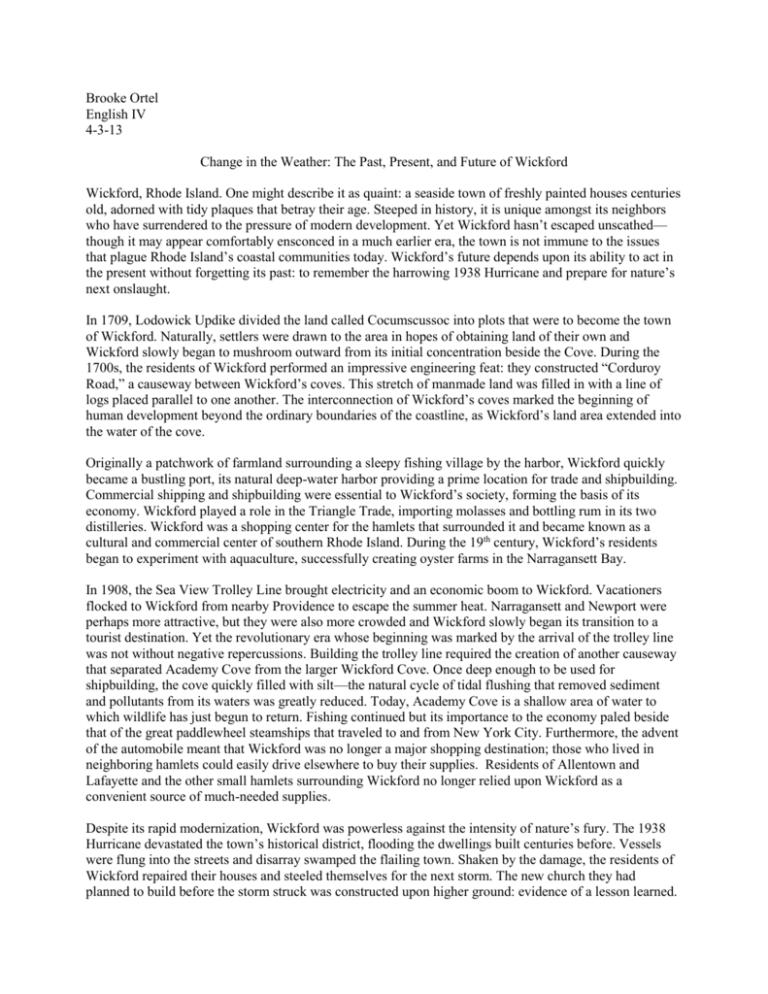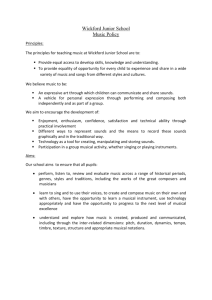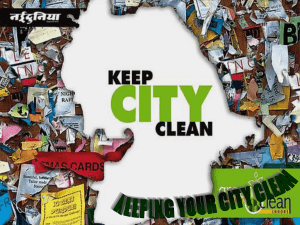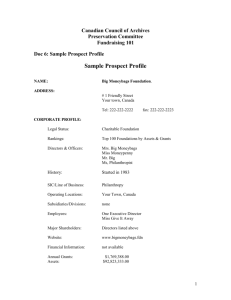Wickford-Change in the Weather (1)
advertisement

Brooke Ortel English IV 4-3-13 Change in the Weather: The Past, Present, and Future of Wickford Wickford, Rhode Island. One might describe it as quaint: a seaside town of freshly painted houses centuries old, adorned with tidy plaques that betray their age. Steeped in history, it is unique amongst its neighbors who have surrendered to the pressure of modern development. Yet Wickford hasn’t escaped unscathed— though it may appear comfortably ensconced in a much earlier era, the town is not immune to the issues that plague Rhode Island’s coastal communities today. Wickford’s future depends upon its ability to act in the present without forgetting its past: to remember the harrowing 1938 Hurricane and prepare for nature’s next onslaught. In 1709, Lodowick Updike divided the land called Cocumscussoc into plots that were to become the town of Wickford. Naturally, settlers were drawn to the area in hopes of obtaining land of their own and Wickford slowly began to mushroom outward from its initial concentration beside the Cove. During the 1700s, the residents of Wickford performed an impressive engineering feat: they constructed “Corduroy Road,” a causeway between Wickford’s coves. This stretch of manmade land was filled in with a line of logs placed parallel to one another. The interconnection of Wickford’s coves marked the beginning of human development beyond the ordinary boundaries of the coastline, as Wickford’s land area extended into the water of the cove. Originally a patchwork of farmland surrounding a sleepy fishing village by the harbor, Wickford quickly became a bustling port, its natural deep-water harbor providing a prime location for trade and shipbuilding. Commercial shipping and shipbuilding were essential to Wickford’s society, forming the basis of its economy. Wickford played a role in the Triangle Trade, importing molasses and bottling rum in its two distilleries. Wickford was a shopping center for the hamlets that surrounded it and became known as a cultural and commercial center of southern Rhode Island. During the 19th century, Wickford’s residents began to experiment with aquaculture, successfully creating oyster farms in the Narragansett Bay. In 1908, the Sea View Trolley Line brought electricity and an economic boom to Wickford. Vacationers flocked to Wickford from nearby Providence to escape the summer heat. Narragansett and Newport were perhaps more attractive, but they were also more crowded and Wickford slowly began its transition to a tourist destination. Yet the revolutionary era whose beginning was marked by the arrival of the trolley line was not without negative repercussions. Building the trolley line required the creation of another causeway that separated Academy Cove from the larger Wickford Cove. Once deep enough to be used for shipbuilding, the cove quickly filled with silt—the natural cycle of tidal flushing that removed sediment and pollutants from its waters was greatly reduced. Today, Academy Cove is a shallow area of water to which wildlife has just begun to return. Fishing continued but its importance to the economy paled beside that of the great paddlewheel steamships that traveled to and from New York City. Furthermore, the advent of the automobile meant that Wickford was no longer a major shopping destination; those who lived in neighboring hamlets could easily drive elsewhere to buy their supplies. Residents of Allentown and Lafayette and the other small hamlets surrounding Wickford no longer relied upon Wickford as a convenient source of much-needed supplies. Despite its rapid modernization, Wickford was powerless against the intensity of nature’s fury. The 1938 Hurricane devastated the town’s historical district, flooding the dwellings built centuries before. Vessels were flung into the streets and disarray swamped the flailing town. Shaken by the damage, the residents of Wickford repaired their houses and steeled themselves for the next storm. The new church they had planned to build before the storm struck was constructed upon higher ground: evidence of a lesson learned. Today, Wickford continues to battle the natural forces that threaten its prolonged existence. Wickford is painfully vulnerable to the effects of climate change. Increased storm intensity and a lengthened hurricane season may prove to be a terrifying combination. The town is built upon artificial land, some of which is supported by log structures that are now centuries old. Can such infrastructure withstand the climactic changes that have already begun to occur? The docks and marinas that line the perimeter of Wickford Cove are highly susceptible to both the effects of sea level rise and extreme weather events. And Wickford’s economy depends upon these waterside facilities—the pleasure-boating provides the town with much of its income. Rising sea level will also wreak havoc on low-lying residential areas. In fact, in one parking lot located in a neighborhood built upon filled land adjacent to the cove, floods monthly, when the tide is highest. Hurricane Sandy may be viewed as a warning: though it did not inflict tremendous damage, it is potentially a harbinger of what is to come. Sobering predictions of climate change are not the only environmental dangers that Wickford faces today. With only six wells, and no viable locations to build another, Wickford’s water supply is fixed. There were once seven wells, but one became contaminated, unsafe to drink. The increased population density and the presence of old cesspools and sewer systems render the town unable to construct new wells. : At some point, possibly in the near future, Wickford will inevitably face water shortages—a serious limiting factor in its development. Unfortunately, the Wickford of 2013 is no longer bustling with local businesses. Many of its storefronts are empty, “For Rent” signs propped in wide, empty windows. Wickford does not even have its own grocery anymore and both the local drugstore and hardware store have gone out of business. Even the chain drugstore that arrived more recently is not likely to survive. Yet Wickford’s economy has not collapsed along with many of its small businesses. The town’s commitment to historical preservation is remarkable. In Wickford, there exists the largest number of colonial homes that function as residences in America. The town has managed to retain its character as a small, colonial village despite centuries of change. Wickford is a “walkable” town and less crowded than Newport and Narragansett—tourism has become increasingly important economically and pleasure-boating represents a growing source of revenue. Fishing and lobstering, also contribute to Wickford’s economy, though to a lesser extent than they once did. What are Wickford’s prospects for the future? Is it to be swallowed by the menace of sea level rise and hurricanes of increased intensity? Hopefully, the town will manage to protect its low-lying historic district, which is particularly vulnerable to extreme environmental conditions, as illustrated by the devastating effects of the 1938 Hurricane. A greater likelihood of flood damage will likely cause flood insurance to increase—as well as living costs. If it is no longer cost-effective for families to live in Wickford, a mass exodus could potentially occur, which would strike the town a fatal blow. But Wickford is not bound to such a gloomy fate. It is certainly possible that residents may determinedly continue to promote historical preservation and adapt local infrastructure to withstand future storms and sea level rise. Perhaps the town can improve water quality by replacing old cesspools and ineffective sewer systems; and perhaps if the town’s groundwater is free of contamination, another municipal well could be dug. Aquaculture, specifically oyster farming, was historically a successful venture and it seems that the residents of Wickford might do well to explore the possibility of reviving this business—it would likely prove profitable and would positively affect the water quality of the cove and harbor. The creation of a bike path tracing the route of the Sea View Trolley Line might attract more visitors to the area, though this would require governmental funding; a feasibility study regarding this very project was conducted years ago, but the path was never built. If Wickford is to achieve future sustainability, its residents must be committed to adapting to the environmental challenges posed by climate change and must be willing to support innovative local business ventures.







